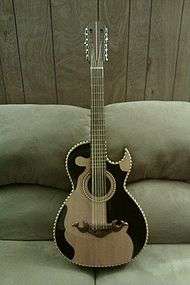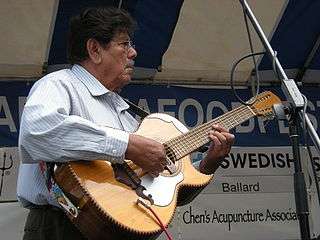Bajo sexto


Bajo sexto (Spanish: "sixth bass") is a Mexican string instrument with 12 strings in 6 double courses. A closely related instrument is the bajo quinto (Spanish: "fifth bass") which has 10 strings in 5 double courses.
In playing, the left hand holds the strings against frets on a fingerboard, while the right hand plucks the strings. When played in older styles of music where the instrument assumes the role of a bass, the strings are usually plucked with the fingers. In modern chordal and melodic styles, a pick is frequently used.
Origins and Use
The history of the bajo sexto is somewhat unclear. There are few written sources, and until very recently most music dictionaries and encyclopedias didn't even mention the instrument. A few contemporary researchers have been working from oral sources—living players and luthiers—to tracing the background of the instrument.[1]
In the 17th and 18th centuries, Mexican artisans built several types of instruments with double strings in three, four, five, six, seven and eight courses, influenced by their Spanish ancestors. Descendants of these instruments are bandolon, guitarra séptima, quinta huapanguera, jarana jarocha, concheros string instruments and guitarra chamula, among others.
The manufacture of bajo quinto and sexto reached a peak in quality and popularity in the 19th century in Southern Mexico, in the states of Guerrero, Michoacán, Morelos, Puebla, Oaxaca and Tlaxcala.[2]
Near the end of the 19th century the bajo sexto began to migrate northwards, where it became a popular instrument for weddings and dances such as the bailes de regalos (popular between 1870 and 1930). In these settings it was usually played along with a set of small tom-tom drums.[3]
The 1930s saw the rise of conjunto music and the instruments of choice for this developing style were accordion and bajo sexto.[4] At this time the bajo sexto functioned primarily as a bass instrument, providing a strong rhythmic foundation supporting the solo accordion. In the late 1940s string bass (and later, electric bass) was added to the instruments, and in the 1950s, drums, completing the modern conjunto ensemble. The inclusion of bass and drums freed the bajo sexto from exclusively rhythmic bass duties, and bajo players began experimenting with chords, counter rhythms, and melodic lines.[3]
As the popularity of conjunto spread northward, the bajo sexto went with it, and the instrument was taken up by musicians in northern Mexico and Texas to play other forms of music: norteño music of northern Mexico and across the border in the music of south Texas known as "Tex-Mex", "conjunto", or "música mexicana-tejana".
Construction and Tuning
The bajo sexto is a member of the guitar family, and physically appears quite similar to a 12-string guitar. There are, however, important differences: the body is usually a bit deeper; the neck is shorter, joining the body at the 12th fret (modern 12-string guitars usually join at the 14th fret); and (being a bass instrument) the strings are thicker. Older instruments tended to have a larger body; modern instruments are more guitar-like, and the body is typically not more than an inch or so deeper than the guitar. Modern instruments frequently have a cut-away in the upper bout, allowing easier access to higher playing positions on the neck, for the left hand.[3]
Since the instrument is tuned an octave lower than the guitar, the body on some instruments isn't really large enough to well resonate the lowest E, and many players remove sixth course, playing on only 10 strings (five courses). Luthiers eventually picked up on this practice and began leaving off the low E course during construction, producing instruments with only five courses—bajo quintos.[5]
Bajo sextos are traditionally tuned in fourths, what a guitarist would call all fourths tuning. The lower three courses are doubled at the higher octave (similar to the lower four courses on a 12-string guitar), and the upper three courses are doubled at the unison:
- E2-E1 A2-A1 D3-D2 G2-G2 C3-C3 F3-F3 (from lowest to highest course)
The bajo quinto derives from the bajo sexto: bajo quintos eliminate the low E course and are tuned:
- A2-A1 D3-D2 G2-G2 C3-C3 F3-F3
The manufacture of bajo quintos and sextos has reached a peak in quality and popularity in the 21st century, mostly in the states of Texas, California and also regions of Mexico.
Notable players

- Rolando Perez (of Conjunto Primavera)
- Cornelio Reyna
- Danny Sanchez (of Intocable)
- Tim Eriksen
- Ry Cooder
References
- ↑ Avetardo, J. T., ed.; Puro Conjunto: An Album in words and Pictures; Center for Mexican American Studies, The University of Texas; Austin, Texas: 2001. 470p. ISBN 0-292-78174-1
- ↑ Bajos de espiga. Diccionario de la Música Española e Hispanoamericana. Sociedad General de Autores y Editores. Madrid (2002). ISBN 978-84-8048-303-2
- 1 2 3 Hernandez, Ramon; An Informal History of the Bajo Sexto; in Aventardo, Ch. 12, pp. 127–130.
- ↑ The Texas-Mexican Conjunto
- ↑ Bajo sexto/quinto